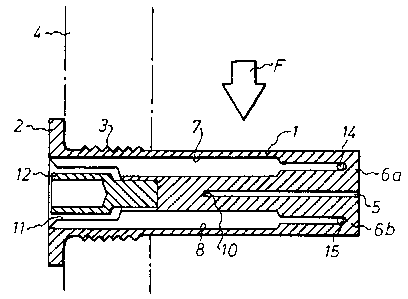Some of the information on this Web page has been provided by external sources. The Government of Canada is not responsible for the accuracy, reliability or currency of the information supplied by external sources. Users wishing to rely upon this information should consult directly with the source of the information. Content provided by external sources is not subject to official languages, privacy and accessibility requirements.
Any discrepancies in the text and image of the Claims and Abstract are due to differing posting times. Text of the Claims and Abstract are posted:
| (12) Patent: | (11) CA 2104577 |
|---|---|
| (54) English Title: | DEVICE FOR MEASURING A GAS FLOW, AND METHOD FOR USING THE DEVICE |
| (54) French Title: | DISPOSITIF DE MESURE D'UN ECOULEMENT GAZEUX ET METHODE PERMETTANT D'UTILISER LE DISPOSITIF |
| Status: | Expired and beyond the Period of Reversal |
| (51) International Patent Classification (IPC): |
|
|---|---|
| (72) Inventors : |
|
| (73) Owners : |
|
| (71) Applicants : |
|
| (74) Agent: | SMART & BIGGAR LP |
| (74) Associate agent: | |
| (45) Issued: | 2001-10-23 |
| (86) PCT Filing Date: | 1992-03-19 |
| (87) Open to Public Inspection: | 1992-10-01 |
| Examination requested: | 1998-12-11 |
| Availability of licence: | N/A |
| Dedicated to the Public: | N/A |
| (25) Language of filing: | English |
| Patent Cooperation Treaty (PCT): | Yes |
|---|---|
| (86) PCT Filing Number: | PCT/SE1992/000169 |
| (87) International Publication Number: | SE1992000169 |
| (85) National Entry: | 1993-08-20 |
| (30) Application Priority Data: | ||||||
|---|---|---|---|---|---|---|
|
A device for measuring a gas flow (F) has a measuring body (1) in the form of
a cylinder, and a heating means (12) for
heating the measuring body. A slot (5) extends axially into the cylinder from
one end thereof so as to divide a first portion of the
cylinder into two symmetrical halves (6a, 6b). The heating means (12) is
disposed in a second cylinder portion which is not di-
vided by the slot (5). A temperature sensor (13) is arranged in the second
cylinder portion, and a temperature sensor (14, 15) is
arranged in each cylinder half (6a, 6b). For measuring a gas flow (F), the
measuring body (1) is so disposed in the gas flow that
the slot (5) extends at right angles to the gas flow with one half (6a) facing
the gas flow and with the other half (6b) facing away
from the gas flow. The measuring body (1) is heated by the heating means (12)
to a temperature exceeding the ambient tempera-
ture by a predetermined value. The temperature is measured in each of the two
symmetrical cylinder halves (6a, 6b), whereupon
the gas flow is calculated on the basis of the measured temperatures.
Note: Claims are shown in the official language in which they were submitted.
Note: Descriptions are shown in the official language in which they were submitted.

2024-08-01:As part of the Next Generation Patents (NGP) transition, the Canadian Patents Database (CPD) now contains a more detailed Event History, which replicates the Event Log of our new back-office solution.
Please note that "Inactive:" events refers to events no longer in use in our new back-office solution.
For a clearer understanding of the status of the application/patent presented on this page, the site Disclaimer , as well as the definitions for Patent , Event History , Maintenance Fee and Payment History should be consulted.
| Description | Date |
|---|---|
| Inactive: IPC from MCD | 2006-03-11 |
| Inactive: IPC from MCD | 2006-03-11 |
| Time Limit for Reversal Expired | 2003-03-19 |
| Letter Sent | 2002-03-19 |
| Grant by Issuance | 2001-10-23 |
| Inactive: Cover page published | 2001-10-22 |
| Inactive: Final fee received | 2001-07-12 |
| Pre-grant | 2001-07-12 |
| Notice of Allowance is Issued | 2001-02-20 |
| Notice of Allowance is Issued | 2001-02-20 |
| Letter Sent | 2001-02-20 |
| Inactive: Approved for allowance (AFA) | 2001-02-02 |
| Inactive: RFE acknowledged - Prior art enquiry | 1999-01-06 |
| Inactive: Status info is complete as of Log entry date | 1999-01-06 |
| Inactive: Application prosecuted on TS as of Log entry date | 1999-01-06 |
| Amendment Received - Voluntary Amendment | 1999-01-05 |
| All Requirements for Examination Determined Compliant | 1998-12-11 |
| Request for Examination Requirements Determined Compliant | 1998-12-11 |
| Application Published (Open to Public Inspection) | 1992-10-01 |
There is no abandonment history.
The last payment was received on 2001-02-01
Note : If the full payment has not been received on or before the date indicated, a further fee may be required which may be one of the following
Patent fees are adjusted on the 1st of January every year. The amounts above are the current amounts if received by December 31 of the current year.
Please refer to the CIPO
Patent Fees
web page to see all current fee amounts.
| Fee Type | Anniversary Year | Due Date | Paid Date |
|---|---|---|---|
| MF (application, 6th anniv.) - standard | 06 | 1998-03-19 | 1998-02-23 |
| Request for examination - standard | 1998-12-11 | ||
| MF (application, 7th anniv.) - standard | 07 | 1999-03-19 | 1999-02-17 |
| MF (application, 8th anniv.) - standard | 08 | 2000-03-20 | 2000-02-16 |
| MF (application, 9th anniv.) - standard | 09 | 2001-03-19 | 2001-02-01 |
| Final fee - standard | 2001-07-12 |
Note: Records showing the ownership history in alphabetical order.
| Current Owners on Record |
|---|
| ABB FLAKT AB |
| Past Owners on Record |
|---|
| ANDERS JOHANSSON |
| LENNART GUSTAVSSON |